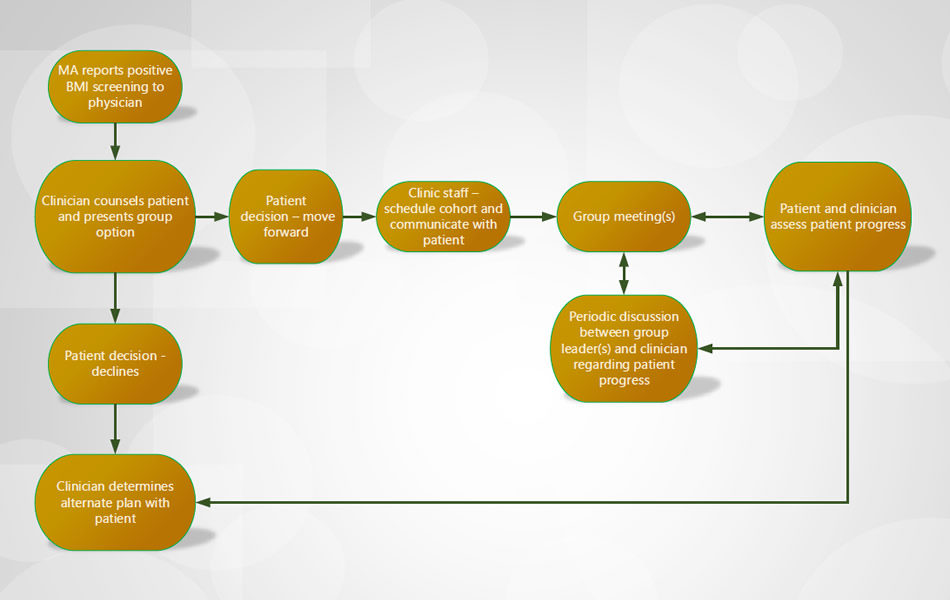Shared Content Block:
Styles -- custom quote
Shared Content Block:
Styles -- "spaced-out" class
Shared Content Block:
Styles -- "smart float" for images
Shared Content Block:
Styles -- restore normal formatting to bulleted and numbered lists
Model: Group Program

In this model, a specified date and time (or multiple for multiple classes) are set for patients to attend a weight management program together with other patients.
Why you might want to choose this model:
- Sometimes it helps to just have an option to point to such as “this is our program and what we have to offer” and a group program works well for this.
- You have or can find an educator (someone who enjoys and is skilled at teaching and facilitating).
- There are group curricula you can borrow, or you can buy an existing program or make up your own. (See info on obesity group medical visits and a sample curriculum.)
- You feel that your patients would benefit from the shared experience of weight management with a group of peers. (There is something special about a group).
What you have to have to make this work:
- You need the space physically to conduct an in-person group
- If you don’t have space, you can conduct the group virtually, in which case you need the technology to conduct the group (such as a telehealth visit) (see other resources)
- There are some logistical and scheduling issues to overcome because you are coordinating people, but we have ideas on how to handle that (see resources). It may be beneficial to have a point person for coordination and scheduling.
How to pay for it:
- Payments for group visits vary by payer. Medicare and Medicare Advantage plans cover group visits of 2 to 10 beneficiaries to deliver IBT services under code G0473, which on average pays $13 per beneficiary per group visit. Private plans may also cover IBT group visits. While Medicare removed all beneficiary co-insurance payments for IBT services, private plans may require a patient co-pay or co-insurance payment.
- Some private plans may cover group visits under CPT code 99078 and you would need to check with each plan for the patients participating in the group visit.
- Medicare, Medicare Advantage, and some private plans permit interactions with individual patients in a group setting with and the provider can bill each individual patient visit using the appropriate E & M code. Some private plans may require a patient co-pay or co-insurance payment in these situations.
- You can make it self-pay and charge patients for the program.
- Some practices do not charge but provide it as a free service to patients using practice improvement funds or incentive dollars.
Who can do it:
- It depends on who you have available in your practice (or can find and make available) and what you can bill for. For individual medical visits billed under E&M codes or the IBT individual code, you need a medical provider to do the part of the group that is medical visit specific.
- If there are not billing constraints, whoever is qualified to do the group session and has the requisite information. We have found that sometimes the group is led by a medical provider (usually an NP or PA), an RDN, or even a peer educator with some knowledge and skills.
What this model looks like in action
Patient story
This story is based on actual patient-care experiences, but is fictional. Any resemblance to real persons is purely coincidental.
Clinicians working in a busy internal medicine practice identified a common need for obesity treatment within their senior patient population. Maya, a nurse practitioner, and Jocelyn, her medical assistant, expressed interest in developing a group weight management program. The two worked with the Quality Improvement team to establish workflows, clarify responsibilities, set up a group template in the EMR, and investigate reimbursement options.
The group decided to use Medicare's Intensive Behavioral Therapy for Obesity benefit, which provides structure and reimbursement for group weight management without copays for beneficiaries. Additionally, Maya and Jocelyn created a curriculum for a full year of meetings. The content was approved by the clinicians who would refer to the program. To reduce costs, Jocelyn and Maya will each cover a portion of the group and complete joint documentation, which will decrease the amount of time they are away from individual patient care.
Bob, a recent widower, is concerned about the significant amount of weight he has gained over the past eight months. He regrets that he has been overindulging in comfort food and hasn't been physically active since losing his partner. His primary care physician suggests that Bob might enjoy being part of a healthy lifestyle and weight management group being held at the clinic. Bob agrees to give it a try.
New group cohorts start as soon as ten people are enrolled. At his first visit, Bob is met by Jocelyn, who runs the group's first 15 minutes. Her duties include taking weights, providing an overview of the day's topic, and discussing relevant resources. Maya leads the group for the next 30 minutes, focusing on group facilitation, patient education, and self-management support for weight management and healthy lifestyles. Bob is encouraged by the interaction with others, some of whom are in similar situations as his own.
Flow diagram
Based on our research, we created this diagram of a typical workflow. This is simply an example of a starting point to consider. You should create a workflow that accommodates the functioning of your practice.

FAQ
It’s such a satisfaction when we have a patient [with] hemoglobin A1C over 8, and they really follow the advice, the recommendation, they come back 3 months later, and it’s 5 or it’s 6, you know. And then they lost this many pounds. We have patients that come here, and they cry when they see these numbers. [They] get so emotional because they thought, you know, that it was not possible to do that. It’s not a difficult—it’s just a matter of persistence, consistency, and you really have to have the emotional courage to fight the feeling of doing the easy thing. That’s the key point. The emotional courage.
Physician Assistant